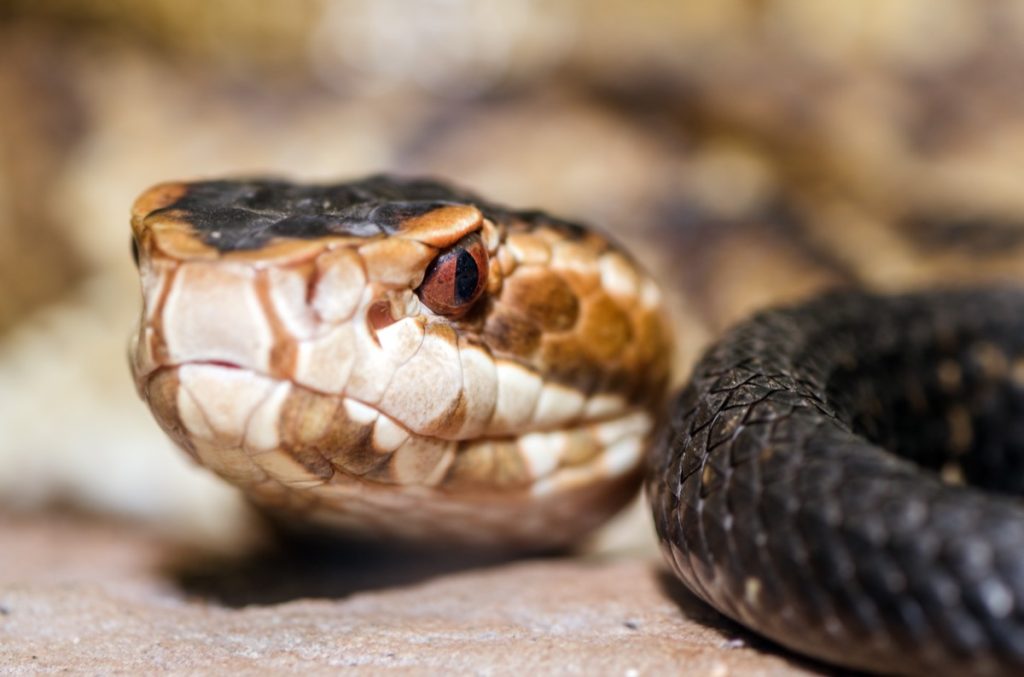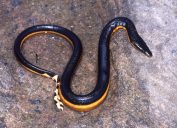If You Live Here, Watch Out for "Snakes All Over the Place," Officials Caution
Recent events have also made run-ins with bears and alligators a serious concern.

It doesn't matter where you live in the U.S.: If you look hard enough in nature or around your property, you're bound to come across a snake. What many may not realize is that the reptiles are typically harmless to humans and even play an important part in natural pest control against creatures you don't want around. Those who live in areas where venomous snakes are more common are also more likely to take care not to accidentally disturb them when they're out in nature or doing yard work. But every so often, certain events make it more likely that you'll cross paths with your slithering neighbors. And now, officials are warning that people in some areas need to watch out as there are "snakes all over the place." Read on to see which part of the country is seemingly overrun with reptiles right now.
READ THIS NEXT: The First Place You Should Check for a Snake in Your Home, Experts Say.
Weather events can affect where snakes and other animals seek shelter.

Even though they get a bad reputation, snakes are naturally timid creatures. Most are simply trying to avoid contact with humans, with most bites happening when they're accidentally disturbed. But similar to humans, certain conditions can change where the reptiles are willing to go and make us more likely to see them.
The same warm weather that brings people out for hikes and backyard parties also appeals to snakes. The cold-blooded animals become more active when temperatures rise, with snake season typically running from April to October in most areas, according to the U.S. Department of Agriculture's (USDA) Forest Service. Heavy rains can also affect where the reptiles head, as many will flee rising waters to seek protection.
Research has even shown that specific weather patterns match up with how often we come across snakes. "The potential for human/pet/snake encounters likely increases with increased snake and human activity during the summer months," Samuel T. Smallidge, a wildlife extension specialist with New Mexico State University, wrote in an email to the Santa Fe New Mexican, citing a 2020 report from the Journal of Environmental and Public Health. "There is some evidence that increased incidence of snakebites following flooding events does occur."
Now, officials are warning residents in some areas of potential reptile run-ins.
Officials are warning that there are "snakes all over the place" in one state.

Florida is still reeling from the devastating effects of Hurricane Ian, which made landfall as a Category 4 storm last week. The historic weather event brought significant flooding to coastal areas, especially around Fort Myers and cities south of Tampa. Officials say that more than 100 people died in the storm and its aftermath, CNN reports.
Residents are now trying to piece together homes and communities that were washed away in storm surges. But in some hard-hit areas, such as Sanibel Island, officials warn of serious danger amid the rubble.
"There are a lot [of] places that are not livable. There are places off their foundation, and it's very dangerous out there," Sanibel Fire Chief William Briscoe told CNN on Oct. 4. "There are alligators running around, and there are snakes all over the place."
RELATED: For more up-to-date information, sign up for our daily newsletter.
Flooding can create dangerous conditions even after the water recedes.

Residents in other nearby areas are also coping with a change in their environment in the wake of Hurricane Ian. Even in areas untouched by coastal storm surges, officials are warning to keep an eye out for animals that may have moved to higher ground to escape flood waters.
"Wildlife may become more visible during and after a storm," the DeSoto County Sheriff's Department wrote in a Sept. 28 tweet. "Please be aware of an extra gator in your pond, snake in your shed, or deer in your pasture."
The damage caused by the storm can also bring by other potentially dangerous wildlife, such as bears. In a Sept. 27 Facebook post, Florida Fish and Wildlife officials warned that bears could become more active, advising that "if spoiled food is included in post-hurricane debris, secure it separately from non-food debris."
There are a few ways to stay safe against snake encounters after a major flood.

Unfortunately for the residents affected by Hurricane Ian's devastation, the most challenging days likely still lie ahead. Roughly 1,000 people have been evacuated from Sanibel after the only roadway connecting it to the mainland was washed away during the storm—and even though people are now allowed back to assess the damage to their property, the island is still "extremely unsafe," Sanibel Mayor Holly Smith told CNN.
Officials still urge Florida residents of any areas affected by floodwaters to stay vigilant for snakes after the hurricane. "You are more likely to see snakes with higher water levels post-storm. Most snakes you will encounter are likely to be nonvenomous and more scared of you than you are of them," Florida Fish and Wildlife write on their website.
"If you see a snake, stay back," the agency advises. "Snakes are not aggressive toward humans unless they feel threatened. They would much rather avoid encounters and will usually flee. To avoid snake bites, leave snakes alone, stay out of tall grass unless you wear thick boots, and keep hands and feet out of areas you can't see."





















